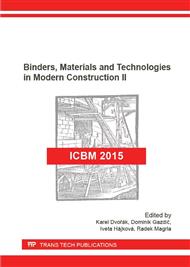p.162
p.167
p.171
p.178
p.183
p.190
p.196
p.201
p.206
Selected Factors Determining Appearing of Efflorescences on Facial Walls
Abstract:
One of problems of facing walls is their aesthetics lowered by efflorescence. Besides workmanship, the main cause is using mortars. It is needed to say that aside from the set: wall element – mortar on most new objects during their first years of usage efflorescence appear of different intensity and chemical compound. Basing on observations of real objects it was found, that intensity of appearing efflorescence change depending on external climate. Detailed researches of influence of selected climatic factors i.e. air temperature and humidity run on field post of facing walls localized in area of University of Science and Technology in Bydgoszcz. The study takes into consideration the following test walls where three different mortar types have been used: Portland cement-based mortar: CEM I, CEM I with plasticizer, cement-lime mortar with CL 90 hydrated lime. The examination analyses performed imply that the critical month for Bydgoszcz is April of each year, when detailed parameters of climate create positive conditions for salt crystallization. In this month efflorescence is reaches the highest level. Arising dripstone and leaks persist for summer period until October and undergo further metamorphose – transferring from efflorescence to the wall interior.
Info:
Periodical:
Pages:
183-189
Citation:
Online since:
August 2016
Authors:
Keywords:
Price:
Сopyright:
© 2016 Trans Tech Publications Ltd. All Rights Reserved
Share:
Citation:


